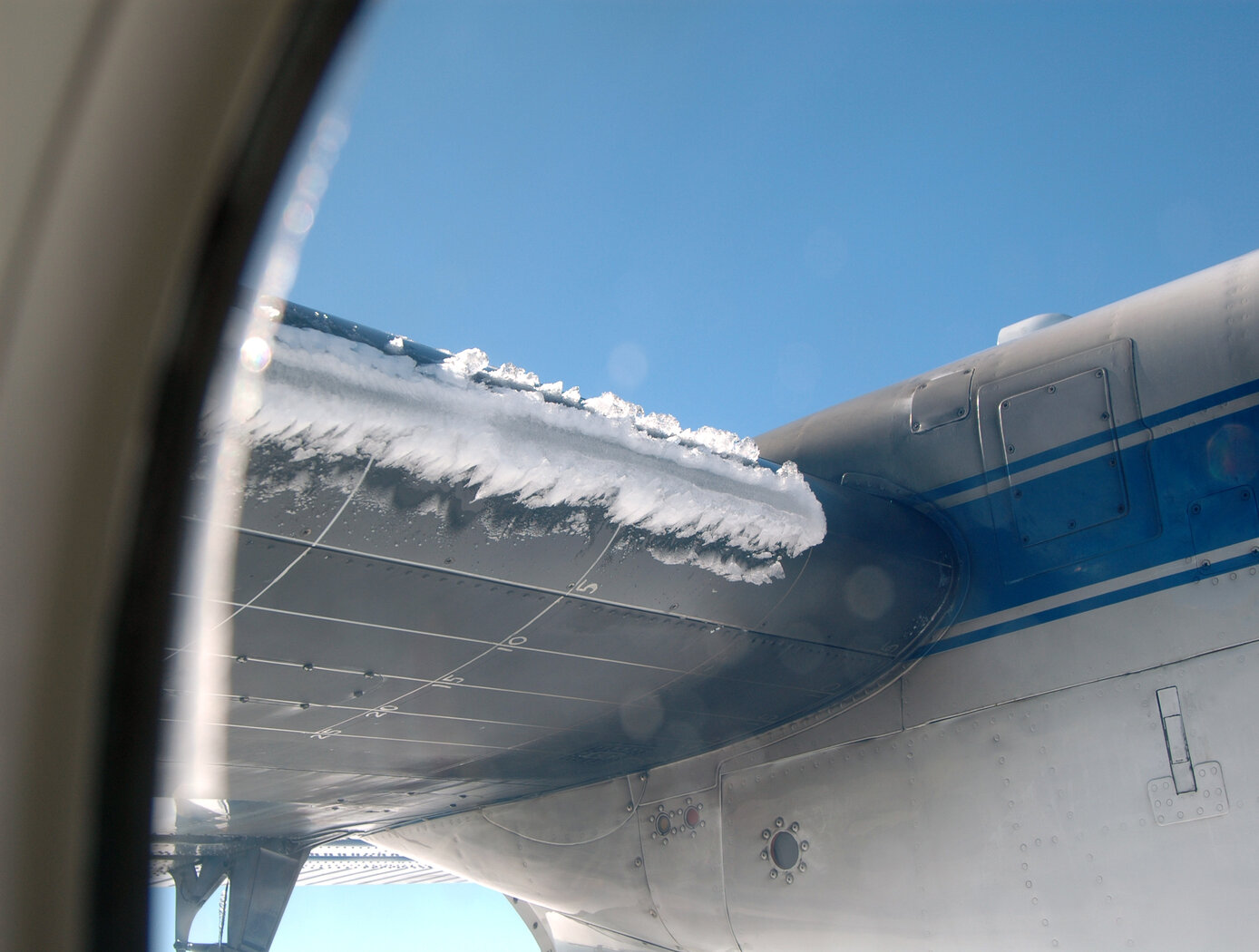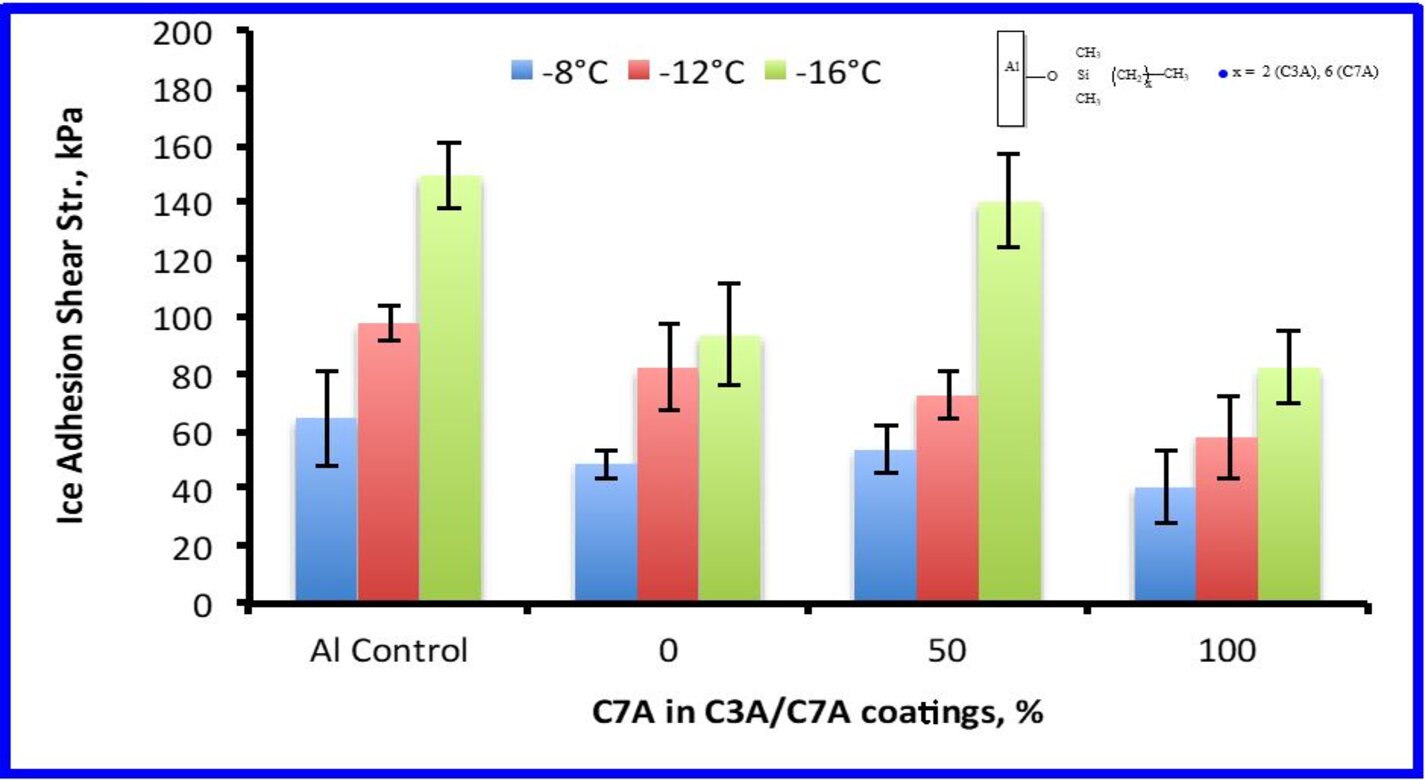New Coatings Reduce Impact Ice Adhesion Strength
Materials and Coatings
New Coatings Reduce Impact Ice Adhesion Strength (LAR-TOPS-353)
Polymer Coatings for Aircraft Surfaces
Overview
Aircraft icing is a serious problem. Wintry conditions on the ground and glaze, rime and mixed icing conditions aloft can cause ice buildup on aircraft wings increasing weight, creating drag, and causing loss of lift —conditions that compromise performance and safety. For commercial aircraft, active icing mitigation strategies —pneumatic boots, heated surfaces, and deicing agents —prevent or mitigate such ice buildup. The challenge is that they also require extra energy, added weight to the aircraft, and increased maintenance complexity. For general aviation and unmanned aerial vehicles that cannot support active anti-icing technologies, avoidance is the only recourse. Thus, there is a need for a passive durable solution for both commercial and general aviation aircraft. Scientists at NASA Langley have been developing passive solutions to this problem focusing on coatings for aircraft surfaces that will reduce the adhesion of impact ice.
The Technology
NASA is developing polymer coatings that reduce impact ice adhesion strength. Current coating compositions are based on epoxy resins due to their availability and ease of fabrication. It is anticipated that a successful composition could be used in other polymer classes such as polyurethanes. Initial molecular modeling studies of silanes terminated with various functionalities suggest that chain mobility effects the interface between ice and the surface. To that end, surfaces coated with these compounds were applied to aluminum substrates and the resulting monolayer coating investigated to assess the effect of chemical functionality and chain length under simulated in-flight icing conditions. As shown in the figure below, these molecular coatings demonstrated reduced ice adhesion strength, presumably as a result of the molecular flexibility imbued by the aliphatic chains that has been incorporated into polymers either within the polymer backbone or as pendant groups. Compared to an untreated aluminum alloy surface, a test polymer coating employing in-chain molecular flexibility exhibited a 56% reduction in ice adhesion strength at -16 C. Similarly, another test polymer coating employing pendant group molecular flexibility exhibited a 19% reduction and a 63% reduction in ice adhesion strength at -16 C compared to an aluminum alloy surface and a rigid epoxy control surface, respectively. The reduced ice adhesion strength may lead to decreased energy requirements for active ice mitigation strategies currently used on aircraft when used in conjunction. These anti-icing coatings are a passive approach that are anticipated to be applied to the aircraft surface either as a topcoat or as a constituent of aircraft paint. The coatings need to be optimized for durability, with the goal of achieving a reapplication frequency consistent with routine aircraft maintenance and painting requirements.


Benefits
- Improves safety by reducing icing on aircraft - the coating is an "always on, always working" solution
- Reduces energy consumption and mass of active systems (when used in conjunction with active systems)
- Expands the operational envelope for smaller aircraft: a passive coating would reduce ice build-up in cold and icing climes
- Anticipated to work with current maintenance schedules: NASA is evaluating coating durability to determine application frequency
Applications
- Commercial Aircraft: reduce in-flight ice accretion on frontal surfaces including the critical wing leading edges
- General Aviation: passive method to reduce ice accretion
- Unmanned Aerial Vehicles (UAVs): passive solution to reduce ice accretion
- Wind turbines passive solution to reduce ice accretion
Technology Details
Materials and Coatings
LAR-TOPS-353
LAR-18585-1
LAR-18585-2
LAR-18755-1
LAR-18755-2
LAR-18780-1
LAR-18585-2-CON
Joseph G. Smith and Christopher J. Wohl, et.al. Effects of Hydrogen Bonding and Molecular Chain Flexibility of Substituted n-Alkyldimethylsilanes On Impact Ice Adhesion Shear Strength. NASA/TM-2020-220567. February 1, 2020.
Joseph G. Smith and Christopher J. Wohl, et.al . Effect of Molecular Flexibility upon Ice Adhesion Shear Strength. Annual Meeting of the Adhesion Society, February 21,2016.
Joseph G. Smith and Christopher J. Wohl, et.al . Durability Characterization of Low Ice Adhesion and Impact Resistance Coatings. 43rd Annual Meeting of the Adhesion Society. March 23, 2020.
Joseph G. Smith and Christopher J. Wohl, et.al . Effect of Molecular Flexibility upon Ice Adhesion Shear Strength. Annual Meeting of the Adhesion Society, February 21,2016.
Joseph G. Smith and Christopher J. Wohl, et.al . Durability Characterization of Low Ice Adhesion and Impact Resistance Coatings. 43rd Annual Meeting of the Adhesion Society. March 23, 2020.
|
Related Links:
|
Similar Results

Capacitive Impedance Water Ice Sensor (CIWIS)
The CIWIS is configured to detect ice, water, and other material accretion on an aircraft's surface using a capacitive sensor comprised of metal traces on a printed circuit board (PCB) with a dielectric surface covering. The traces are on the bottom side of the PCB for protection from the elements experienced on the top side. It drives the sensor with a sinusoidal signal and monitors the sensed sinusoidal signal from the sensor. By electronically measuring the RMS voltage of both the drive and sensed signal as well as the phase shift introduced by the sensor, the CIWIS can determine the impedance of the sensor and any material deposition. When a material is present on the surface, this introduces another capacitor in parallel with the air and PCB, with that material being another dielectric.
Water and ice exhibit frequency-dependent permittivity that introduces a phase shift unlike that of a typical capacitor. CIWIS leverages these differences, distinguishing materials by the unique RMS levels and phase shifts they produce in the sensor. For ice, this effect occurs at approximately 10 kHz.
While NASA originally developed the CIWIS to detect ice on aircraft, it may also be useful to sense the presence of water and other contaminants in pharmaceutical production; condensation in heating, ventilation, and air conditioning (HVAC) systems; and ice accumulation on cryogenic equipment. This technology is available for patent licensing, and is rated at a Technology Readiness Level or TRL of 5 , meaning it has been developed and validated in an industrially relevant environment and is ready for a prototype demonstration.

Hydrophobic Epoxy Coating for Insect Adhesion Mitigation
This technology is a copolymeric epoxy coating that is loaded with a fluorinated aliphatic chemical species and nano- to microscale particle fillers. The coating was developed as a hydrophobic and non-wetting coating for aerodynamic surfaces to prevent accumulation of insect strike remains that can lead to natural laminar flow disruption and aerodynamic inefficiencies. The coating achieves hydrophobicity in two ways. First, the fluorinated aliphatic chemical species are hydrophobic surface modification additives that preferentially migrate to the polymer surface that is exposed to air. Secondly, the incorporation of particle fillers produces a micro-textured surface that displays excellent resistance to wetting. Combined, these two factors increase hydrophobicity and can also be used to readily generate superhydrophobic surfaces.

Synthesis and Development of Polyurethane Coatings Containing Fluorine Groups for Adhesive Applications
Coatings offer an advantage over previous strategies due to ease of application, potentially negligible weight penalty, reduced environmental concerns, better economics, and continual function throughout the flight profile. In this present innovation, a particular coating has been developed that is similar to the basic component of a majority of aerospace coatings used on commercial aircraft. This coating was then sprayed from a solvent on various substrates. Once spray-coated on a substrate and dried, the coatings were then tested for adhesion mitigation of insect residues in a controlled insect impact facility propelled toward the engineered surface at approximately 150 mph. Once impacted, these coatings demonstrated hydrophobicity and a significant reduction in contaminant adhesion. The coatings were further tested in an operational environment on the eco-demonstrator Boeing 757 aircraft. The coatings resulted in lower insect accumulation than the control surface (no coating). The durability of these coatings was comparable to state-of-the-art formulations and satisfies current aircraft manufacturing requirements. These coatings likely have advantageous use in aerospace applications, wind turbine systems, and automotive industry, among other industries.
This innovation not only appears to solve a problem that has persisted, thus fulfilling an unmet need, but also comprises a new composition of matter that can lead to numerous unforeseen applications.

Transformable Hypersonic Aerodynamic Decelerator
The invention allows the deployment of a large aerodynamic decelerator relative to the size of its launch vehicle, which is controllable and can be transformed into a landing system. A structure composed of a radial assembly of ribs and struts in a four bar linkage arrangement fits inside a launch vehicle shroud, expands into a deployed size, and permits rotation about a pivot point along the vehicle axis. The mechanism that deploys the decelerator surface, doubles as the actuation/control mechanism, and triples as the payload surface leveling system. The design permits the use of conformable thermal protection systems at the central part and a flexible TPS, 3-D woven carbon fabric, as skin in the majority of the regions of the aeroshell entry system. The fabric handles both the heat and mechanical load generated during entry. This system is very mass competitive with other lightweight systems such as inflatable and rigid decelerators and is believed to be more reliable and testable at sub-scale. Once the payload reaches its destination, the decelerator structure leverages atmospheric drag to slow the craft from hypersonic travel speeds to an appropriate landing velocity. The decelerator can be actuated during descent to generate lift and steer the payload to its intended destination. Retro propulsion engines provide the final deceleration just before landing, and the decelerator structure is inverted to act as a landing platform and help minimize the impact of landing load.

Chemical and Topographical Surface Modifications for Insect Adhesion Mitigation
The technology is a method of mitigating insect residue adhesion to various surfaces upon insect impact. The process involves topographical modification of the surface using laser ablation patterning followed by chemical modification or particulate inclusion in a polymeric matrix. Laser ablation patterning is performed by a commercially available laser system and the chemical spray deposition is composed of nanometer sized silica particles with a hydrophobic solution (e.g. heptadecafluoro-1,1,2,2-tetrahydrodecyltriethoxysilane) in an aqueous ethanol solution. Both topographic and chemical modification of the substrate is necessary to achieve the desired performance.



